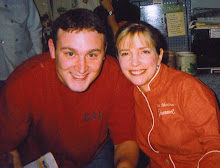The lemon-pepper mix is carefully stuffed between the skin and the meat before the duck is roasted, imbuing the bird with its tangy-spicy flavor. An advantage of this recipe is that you can serve perfectly cooked and crisped duck while avoiding last-minute struggles with carving.
The recipe can easily be doubled and would make a fantastic main course for a dinner party! As always, using the freshest ingredients are crucial to the successful flavors of this dinner.
Roast Lemon-Pepper Duck with Red Wine Vinegar Sauce
Serves 2
1 whole duck, about 4.5 pounds
1 Tablespoon lemon zest
1/2 teaspoon minced fresh thyme leaves
1/2 teaspoon coarsely ground black pepper
1/2 teaspoon kosher salt
1/4 cup chopped bacon
1/2 Tablespoon chopped garlic
1/4 cup sliced shallots
1 small sprig each of thyme, rosemary, and sage
1 anchovy fillet
1/2 Tablespoon unbleached all-purpose flour
1/4 cup red wine vinegar
1 1/4 cup Veal stock*
pinch kosher salt
pinch freshly ground black pepper
*If you can not find veal stock, you can substitute a mix of 3/4 cup of beef stock and 3/4 cup of chicken stock. Very important: Use products labeled "stock" not "broth." There is a substantial difference in flavor. Stock is thick and rich, broth is thin. A good stock should turn to a gel when chilled in the fridge. Broth will not gel up, but develop a layer of congealed fat on the surface.
Preheat the oven to 425 degrees.
Remove the neck, giblets, and livers from inside the cavity of the duck. Cut the wings at the first joint. Cut the extra large flap of neck skin (if there) off just at the point where the breast begins. Reserve the cut wing tips, the neck skin, livers and giblets for the sauce.
Combine the lemon zest, thyme, pepper, and salt in a small bowl. Beginning at the tip of the breastbone and working back toward the legs and thighs, use your fingers to create a pocket between the meat and skin, gently separating the skin from the body of the duck. Tuck the lemon-pepper mixture evenly into the pocket, covering each breast, leg and thigh. Tie the legs together with kitchen twine.
Heat a roasting pan with a rack in the oven for 10 minutes. Place the prepared duck breast side up on the rack and cook for an hour and 10 minutes. Remove the duck from the pan and bring to room temperature. Pour the rendered fat that has collected in the bottom of the pan into a sealable container and save for a future recipe. (Rendered duck fat sells for $9 for a 1/4 cup!)
While the duck is roasting, make the sauce.
To make the sauce, brown the bacon over medium heat in a 2-quart saucepan. Pour off all but 1 tablespoon of the bacon fat, leaving the bacon in the pan. Add the duck livers, wing tips, giblets, neck skin, garlic, shallots, herbs, and anchovy and brown over moderate heat for 8-10 minutes. Sprinkle with the flour and cook, stirring, until golden brown. Deglaze the pan with the red wine vinegar, stirring to incorporate the flour into the liquid, and boil for 1 minute. Add the veal stock, lower the heat, and simmer, uncovered, 45 to 60 minutes. Strain the sauce in a mesh strainer, pressing the solids to extract the maximum amount of sauce. Correct the seasonings with salt and pepper and keep warm.
When the duck has finished roasting and has come to room temperature, preheat the oven to 450 degrees.
Cut the duck breasts and legs from the carcass. Trim off any excess fat around the breast and leg. Heat an ovenproof skillet over high heat and add the duck pieces, skin side down. Cook over high heat until the skin begins to sizzle, about 1 minute. Lower the heat and gently crisp the duck skin for 5 minutes. Drain off any excess fat. Cover tightly with a lid or aluminum foil and place in the oven. Cook for ~10 minutes until the skin is crisp and the meat cooked through and moist.
Serve immediately with the sauce.

Enjoy!





